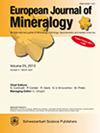水热蛋白石的近红外特征:以冰岛硅烧结矿为例
IF 1.7
3区 地球科学
Q2 MINERALOGY
引用次数: 0
摘要
摘要二氧化硅矿物是评估生命起源或生命出现可能性的主要指标。在地球上,古老的热液石英沉积物保存了最古老的生命形式。在地球之外,通过轨道近红外(NIR)遥感和原位探测车探测,已经在火星上观测到这种富含二氧化硅的热液系统。这项工作调查了在温泉的单一地质背景下,蛋白石的质地和近红外特性随温度的变化。在冰岛的温泉田、雷克霍尔特地区和Hveravellir地点取样了硅烧结矿,水温从14°C到101°C不等。近红外光谱特征(凹凸比标准,CRC)的变化随流体温度、岩相和显微结构而变化。只有高温样品显示高CRC值(CRC5200>0.85),低CRC值(CRC5200 <0.75)在任何温度下测量。因此,温度不是控制蛋白石光谱特性的唯一参数。其他几个参数,如水动力环境、微生物活动、二氧化硅微结构和孔隙度也可能影响二氧化硅沉淀、水的掺入和形态,从而影响其近红外特征。观测结果表明,使用近红外光谱特征来解释地球或火星上化石蛋白石的地质背景存在局限性:只有具有高CRC值的蛋白石才能推断为由热液活动形成。低CRC值可归因于低温热液活动(<50-60°C)或耐大陆风化。本文章由计算机程序翻译,如有差异,请以英文原文为准。
Near-infrared signature of hydrothermal opal: a case study of Icelandic silica sinters
Abstract. Silica minerals constitute a main target to assess the origin of life or the possibility of its emergence. On Earth, ancient hydrothermal silica deposits have preserved the oldest forms of life. Beyond Earth, such silica-rich hydrothermal systems have been observed on Mars by orbital near-infrared (NIR) remote sensing and in situ rover exploration. This work investigates the variations of texture and NIR properties of opal with temperature, within a single geological context of hot springs. Silica sinters have been sampled in Icelandic hot-spring fields, in the Reykholt region, and at the Hveravellir site, with water temperature ranging from 14 to 101 ∘C. Variations in the NIR spectral features (concavity ratio criteria, CRC) vary with fluid temperature, lithofacies, and microtexture. Only high-temperature samples display high CRC values (CRC5200>0.85), but low CRC values (CRC5200 < 0.75) are measured for any temperature. Hence, temperature is not the only parameter controlling spectral properties of opal. Several other parameters such as the hydrodynamic context, the microbial activity, silica micro-textures, and porosity may also affect silica precipitation, the incorporation and speciation of water in it, and thus its NIR signature. The observations suggest a limitation in the use of NIR spectral features for the interpretation of the geological context of fossil opal on Earth or Mars: only opal with high CRC values can be inferred as being formed by hydrothermal activity. Low CRC values can be attributed to either low-temperature hydrothermal activity (< 50–60 ∘C) or to continental weathering.
求助全文
通过发布文献求助,成功后即可免费获取论文全文。
去求助
来源期刊
CiteScore
2.80
自引率
9.50%
发文量
40
审稿时长
6-12 weeks
期刊介绍:
EJM was founded to reach a large audience on an international scale and also for achieving closer cooperation of European countries in the publication of scientific results. The founding societies have set themselves the task of publishing a journal of the highest standard open to all scientists performing mineralogical research in the widest sense of the term, all over the world. Contributions will therefore be published primarily in English.
EJM publishes original papers, review articles and letters dealing with the mineralogical sciences s.l., primarily mineralogy, petrology, geochemistry, crystallography and ore deposits, but also biomineralogy, environmental, applied and technical mineralogy. Nevertheless, papers in any related field, including cultural heritage, will be considered.

 求助内容:
求助内容: 应助结果提醒方式:
应助结果提醒方式:


